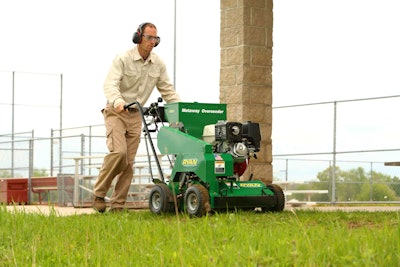 Photo: Ryan Turf
Photo: Ryan TurfLawn damage caused by colder weather is a common problem for homeowners across the country. Sometimes called winterkill, it can affect anywhere from a small patch of grass all the way up to damaging a large portion of the lawn.
Common types of winterkill include crown hydration, snow mold and winter desiccation. Crown hydration occurs when the grass thinks it’s spring and takes on water, only to have it freeze again, killing the plant. This is especially common during mild winters when the ground thaws and refreezes several times.
Snow mold is a cold-weather fungi usually affecting cool-weather grasses. It’s caused when a heavy blanket of snow falls before the ground has frozen. The snow’s weight combined with heavy moisture and/or lawn debris creates ideal conditions for snow mold.
Signs of snow mold are usually most noticeable in the spring when the snow begins to melt. As the snow melts, circular patches ranging from a few inches to several feet across appear in the lawn. The grass in these patches is usually matted down and crusty. Pink snow mold (patches are whitish-pink) can kill the crown and roots of grass plants; gray snow mold (patches are grayish-white) typically only damages the grass blades.
 A spot of dead grass.
A spot of dead grass.Add winter desiccation to the long list of what can happen to your lawn during the winter months. Winter desiccation takes place when the turfgrass plant is in its dormant or semi-dormant stages and can cause varying degrees of damage. All turfgrass species are prone to winter desiccation if the right conditions persist. Winter desiccation occurs when the leaves and other parts of the turfgrass plant are damaged often to the point of death because its roots are unable to supply enough water to keep up with the amount of water the turfgrass plant is losing to the atmosphere.
Snow provides valuable moisture, and acts like a blanket, insulating the turfgrass and covering it from the potential harsh winter winds and unfavorable conditions. Without snow coverage, preventing damage from desiccation is difficult if susceptible site conditions exist or the weather conditions are less than ideal. The most severe turf winter damage typically occurs when there is no snow coverage and dry, windy conditions persist.
Remedies for winterkill
There are typically two options for dealing with winterkill: reseeding or replacing. Reseeding makes sense for smaller areas or patches of damaged grass, while re-sodding makes more sense for larger plots.
Seeding or overseeding can take place after the snow has melted and the risk of frost is over. It may help to dethatch and/or aerate the area to provide better access to the soil and roots. Ryan makes a variety of products that can help with these tasks, including the Ren-O-Thin power rake, Lawnaire IV walk-behind aerator and Mataway overseeders and dethatchers. After preparing the area, simply add seed and water to begin your repair.
If the area to be repaired is larger, a product like the Ryan Jr. Sod Cutter is ideal for removing damaged turf. With its user-friendly controls and swiveling rear wheel, the Jr. Sod Cutter makes it easy to remove large swaths of sod or cut closely along contoured landscape edges. Once the damaged turf is removed, new sod can be installed and watered as necessary. Sod is an instant, weed-free solution to replacing a large area that has been damaged.
Finally, add compost or fertilizer. If fertilizing, choosing a product that is formulated for the specific lifecycle of the lawn is key to making sure the lawn is receiving the nutrients it needs to excel.
EDITOR’S NOTE: This article was provided by Ryan. Ryan specializes in turf renovation equipment including aerators, overseeders, sod cutters and more.











